 Colored vinyl records
Colored vinyl records
20 vinyl & record player accessories

Soon after you start a record collection and get into vinyl more and more, you discover that there are specific accessories designed to help your vinyl and record player stay in good shape for longer and provide a more enjoyable analog experience. Below we listed 20 vinyl and record player accessories to keep your collection clean, organized and make certain upgrades that will help you get the best sound out of equipment.
Turntable Platter Mats
Choosing the right turntable platter mat is essential to achieve an increased sound quality by reducing friction, dampening vibrations and avoiding static build-up. A good turntable mat grips both the platter and the record firmly, so there are no slips while spinning, and significantly diminishes distortions of mechanical origin. The material it's made of, although doesn't generate sound by itself, should have good sound characteristics. The most used ones are made from felt, cork, leather, acrylic and rubber each having different properties that offers special sound characteristics and create a good listening experience. Rubber mats for example are especially good at dampening vibrations while cork mats are popular among audiophiles for opening up the sound spectrum. The mat also protects the record's surface so it must be kept clean and dust free to avoid small particles settling in the grooves.
-

Music Hall Cork Platter Mat -
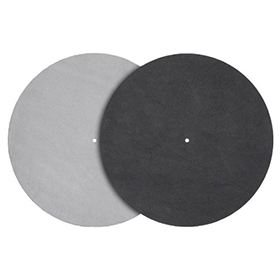
Pro-Ject Leather It Platter Mat -
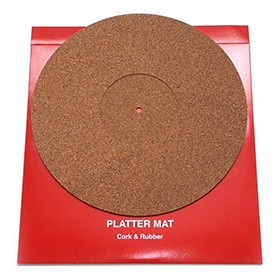
Thorens Platter Mat Cork & Rubber -
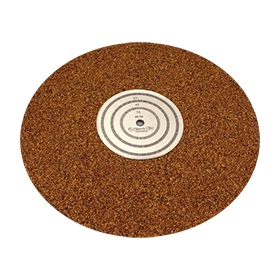
Sleeve City Cork Rubber Mat
Slip Mats
Unlike platter mats which hold the record firmly, slip mats are designed to let the record slip over the rotating platter for cueing and scratching and to allow a DJ to manipulate the record without damaging it. They are usually made of felt and are also commonly used as decoration for when a record isn't on the turntable. If you plan on DJing, you need slip mats to cue and scratch, but if you are listening only you need a platter mat.
-
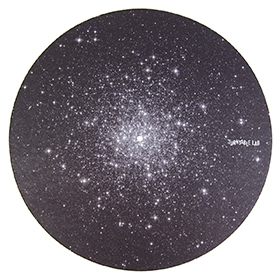
Turntable Lab: Spacemat Record Slipmat -
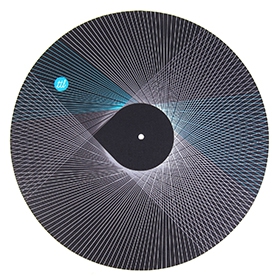
Turntable Lab: MMF.TTL Slipmat -
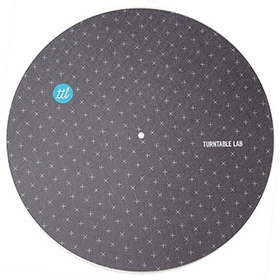
Turntable Lab: PH Slipmats -
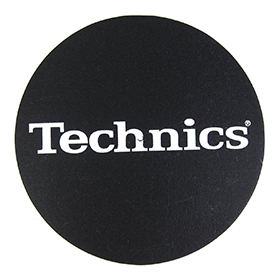
Technics Classic Slipmats
Turntable record clamp / stabilizer weight
Record clamps are weights, generally only used by audiophiles, that fit on the spindle of a record player and are designed to ensure the stability of the vinyl for a better tracking. They will help flatten the record to the platter, and by this, keep resonances and unwanted needle motions to a minimum. You will get the most benefit of a record clamp when playing thin, flexible, slightly warped or bowed vinyl, but it won't eliminate warping or bowling completely. This is important when trying to digitally archive your vinyl, and you want to capture the best recording possible. There are three main clamping methods used to fit the weight on the spindle: unthreaded (has a spindle hole in the bottom that simply fits over any spindle), threaded (which screws onto a turntables threaded spindle), collet style (you need to turn a knob to grab the spindle). Disc stabilizer weights are larger, heavier and use a high density metal that helps eliminate unwanted vibrations that affect sound quality.
-
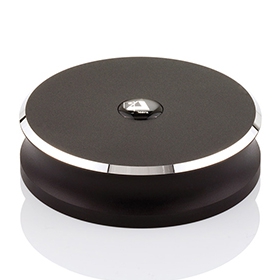
Clearaudio: Concept Record Clamp -
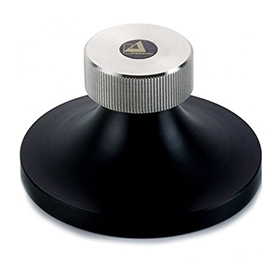
Clearaudio: Twister Clamp -

Audio Technica: AT618 Disc Stabilizer -
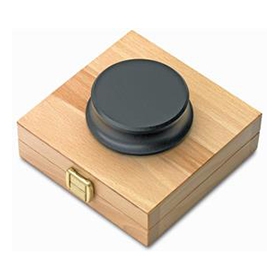
Pro-Ject Audio Record Puck
45 RPM adapter
A 45 adapter also known as 7 inch adapter is a small plastic or metal insert that fits the middle of a 45-rpm record so it can be played on the spindle of a turntable.
-
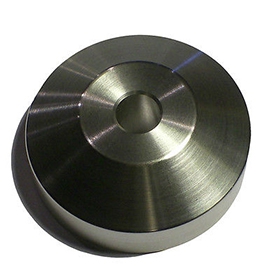
Stainless Steel 45 Adapter -

Gold Aluminum Dome Adapter -
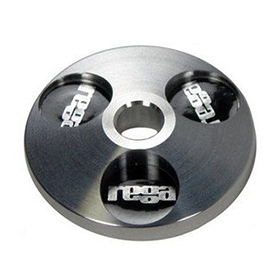
Rega: 45 Adaptor -
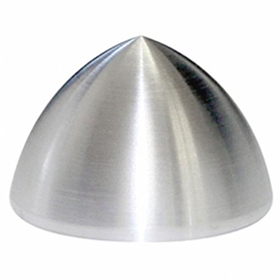
45 Central: Bullet 45 Adapter
Precision bubble level gauge
A perfectly level turntable is the essential first step before setting up, playback or making other adjustments. With this small, handy accessory you can easily check your record player's mount level, accurately set a stable positioning and avoid any sloping.
-
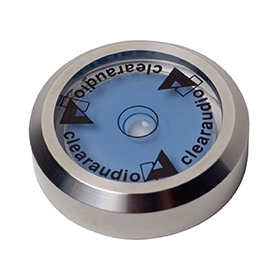
Clearaudio: Precision Bubble Level -

Audio-Technica: AT615 Level -
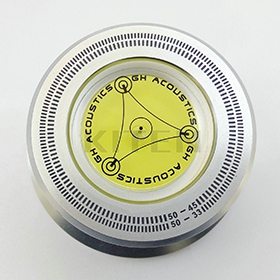
3 in 1 Record Clamp, Stabilizer, Level -
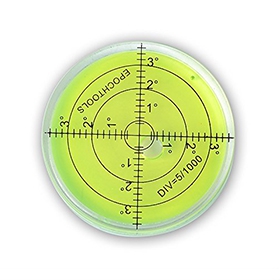
Biligo Level
Cartridge alignment protractor
The process of aligning a phono cartridge perfectly is not an easy procedure, but protractors help any amateur do a pretty good cartridge alignment for better sound quality and longer stylus life. An alignment protractor is a plastic or paper template onto which are printed the null points and lines of tangency against which the cartridge should be aligned. Basically, you place the template over the spindle and against the platter an adjust your cartridge until the cantilever (not the cartridge body!) is parallel to the set of parallel lines. You can find printable cartridge alignment protractors over at Vinyl Engine or check out the ones below.
-
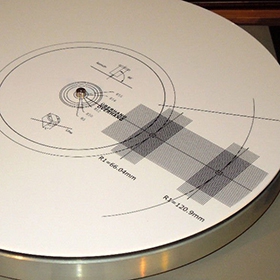
Pro-Ject: Strobe It -
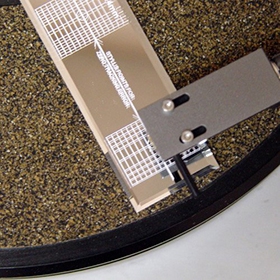
Cartridge Alignment Protractor -

Cartridge Alignment Protractor Mirror -
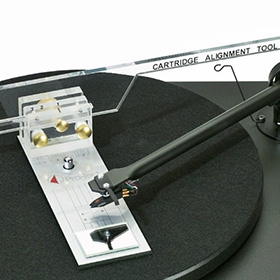
Pro-Ject: Align It
Stylus tracking force gauge
The tracking force gauge is a simple budget tool used to accurately measure the stylus tracking force. The tracking force is the downward pressure that is applied by the weight of the tonearm through the cartridge and stylus onto the record. Setting the proper tracking force is essential for optimal playback and to minimize needle and vinyl wear. If it's too heavy, the sound becomes thick and sluggish and if it's too light your cartridge is more likely to skip and the sound will be light and weak. Using the tracking force indicator on the tonearm can be inaccurate so a dedicated stylus force gauge will help you set the force by the cartridge manufacturers specifications.
-
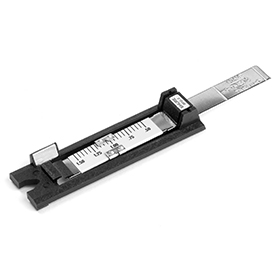
Shure SFG-2 Stylus Tracking Force Gauge -
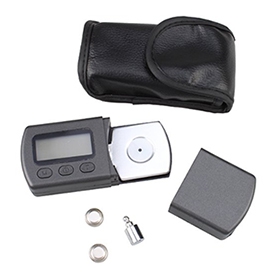
Digital Turntable Stylus Force Gauge -
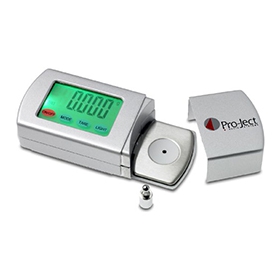
Pro-Ject Audio: Measure it II -
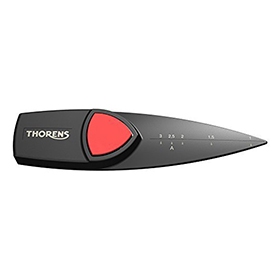
Thorens Stylus Gauge
Isolation feet and pads
Isolation feet are one of those accessories that you could install on your record player to significantly enhance its sound quality. They have excellent vibration dampening qualities and will isolate the turntable from your cabinet or floor to remove any disruptions originating from the appliances in your home. Stiffer feet should be used with heavier turntables, while flexible and looser feet are ideal to use with lighter turntables.
-
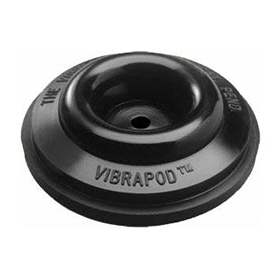
Vibrapods -

Isonoe: Isolation System - Turntable Feet -
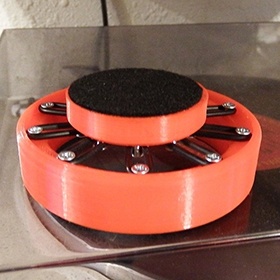
3.5" Suspended Isolation Pad -
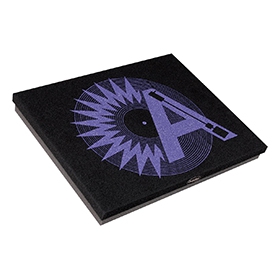
Auralex Acoustics ISO-Tone Turntable
Anti-static carbon fiber brush
This is a must-have accessory for everyone who owns and listens to records. You should use it before and after every playback to prevent the build-up of dust and other impurities. The fibers of the brush have been designed to work their way deep into the grooves and remove loose particles from the surface of the record which affect sound quality. It also reduces the static build-up. Simply rotate the record on the turntable and gently hold the carbon fibers in the grooves for about 2 to 3 revolutions. After these rotations angle the brush toward the outside of the record and carefully sweep the particles off the vinyl surface. But be aware, these brushes are not for cleaning records, every once in a while you should wet-clean your collection.
-
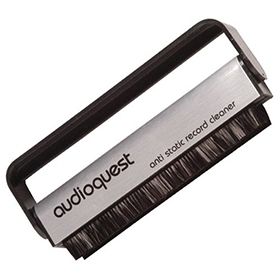
AudioQuest Carbon Fiber Record Brush -
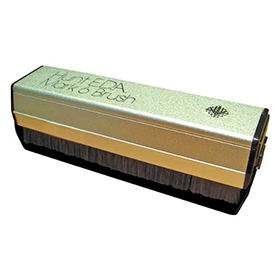
Hunt: EDA Mark 6 Carbon Fiber Record Brush -
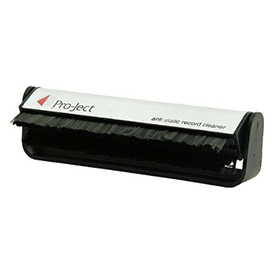
Pro-Ject: Brush It - Carbon Fiber Record Brush -
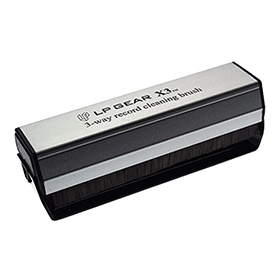
LP GEAR X3 Record Cleaning and Anti-static Brush
Record cleaning brush pads and kits
If you need a fast deeper cleaning, these can be used as a wet-cleaning brush or as a dry record brush. They usually come with a vinyl cleaning solutions and a soft cleaning pad that really gets deep into the grooves, removing dust and other particles fro
-
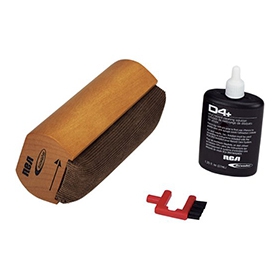
RCA RD-1006 Discwasher Vinyl Record Care System -
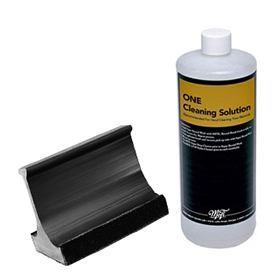
Mobile Fidelity: Record Cleaning Brush -
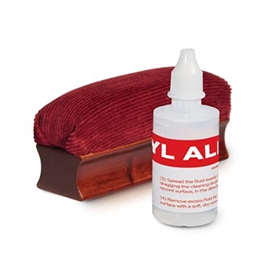
ION Vinyl Alive Professional Vinyl Cleaning Kit -
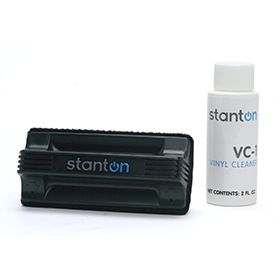
Stanton Magnetics Record Cleaner Kit
Stylus cleaner
Dirt and dust on your records will coat your stylus's diamond tip very quickly, and will compromise playback. Even if your records are clean, a dirty stylus can heavily affect sound quality. Ideally, the stylus should be cleaned after every few listens, but this depends on how dirty your records are. You can quickly check the amount of contamination of the stylus tip before a playback, by using a magnifier glass. Luckily there are many stylus cleaning kits and tools on the market, so you don't have to use DIY methods which in some case can do more harm than good. Make sure to turn your phono amp off or mute your speakers when cleaning the stylus tip.
-
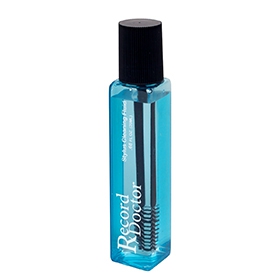
Record Doctor: Stylus Cleaning Fluid with Brush -
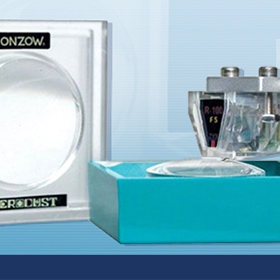
Zerodust Onzow stylus tip cleaner -
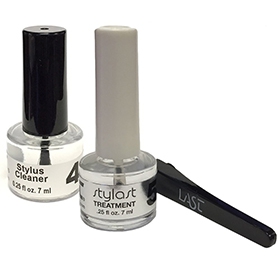
Last: Stylus Cleaner & Stylast Pkg -

Diskeeper SC5 Stylus Cleaner
SpinClean record cleaner
The Spin-Clean® has been on the market for about 40 years, used worldwide, and lauded by record collectors, libraries, radio stations and audiophiles everywhere. The cleaning system consists in a thin tray with two removable velvet brushes and two removable rollers. It kit also comes with wash fluid, a pair of drying cloths and instructions to guide you through the cleaning process. It's the most affordable solution if you have a large record collection and want to clean every one of them quick and easy. It also does an incredible job cleaning the dirtiest, most worn-out records you find at any thrift shop or garage sale.
-

Spin-Clean - Complete System Mk2 -
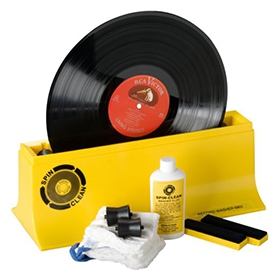
Spin-Clean - Starter Kit Mk2 -

Spin-Clean - Washer Fluid 8 Oz -
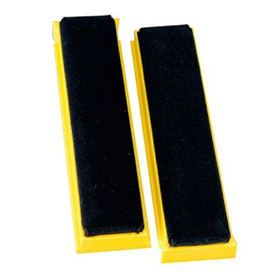
Spin-Clean - Mk2 Replacement Brushes
Lint-free microfiber cloth
These are one of those inexpensive things every record owner should have around their collection. microfiber cloths are made up of woven fibers that are very small and are great for cleaning delicate surfaces (like lenses). A good quality, non-abrasive microfiber cleaning cloth has exceptional ability to absorb oil and moisture from the record surface and it's tiny fibers hang onto dust and grime without being abrasive and damage the record, unless it retained hard particles from an earlier use. You can use these to dust off vinyl or dry them after a wet-clean.
-
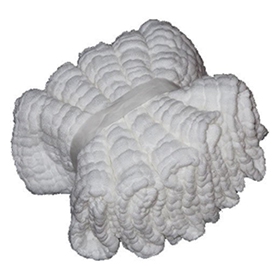
Spin Clean - Dry Cloths -

Eurow Microfiber -
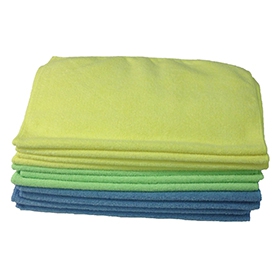
Zwipes Microfiber Cleaning Cloths -
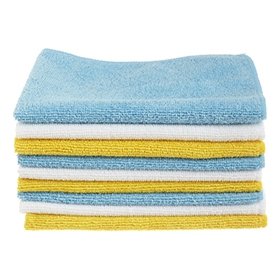
AmazonBasics Microfiber Cleaning Cloth
Turntable dust covers
If your turntable didn't come with a dust cover (as many higher-end ones don't), you should definitely find a solution to cover your equipment when it's not in use. It will provide protection from dust, dirt or spills and will likely prolong it's playing life. Also a hard cover protects the tonearm and cartridge from accidents and keeps away your children or pets from getting to your record player's delicate parts.
-
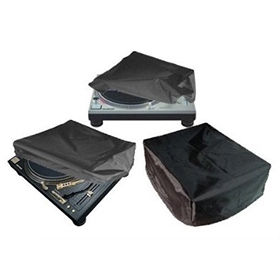
Universal Nylon Turntable Dust Cover -
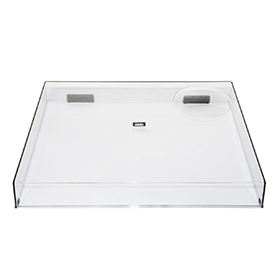
Dust Cover for Technics Turntable 12003D/MK5/MK6 -
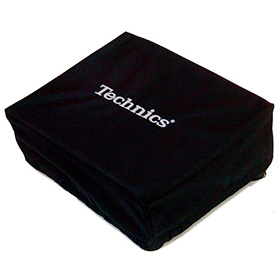
Technics: Embroidered Deck Turntable Cover -
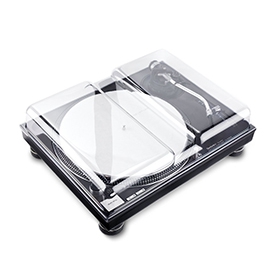
Decksaver Protective Cover for Technics SL-1200/1210
Record inner sleeves
Protecting your records while being stored is an important part of prolonging their life. Inner sleeves are the ones your record goes in before you put them inside the artwork cover sleeve. Their main purpose is to protect the record's surface from the paper dust and other impurities found inside the cover. There are three main types of inner sleeves: paper, plastic and paper with poly lined inner surface. Poly-lined and plastic inner sleeves help reduce static and offer more protection against scratches, than paper ones.
-
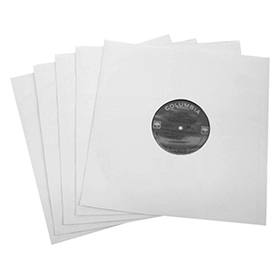
2" Paper & Plastic Poly-Lined Record Inner Sleeves -
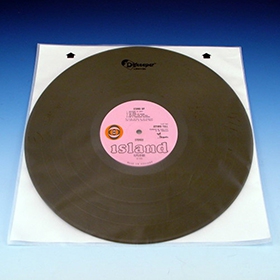
Diskeeper Audiophile Inner Record Sleeves -
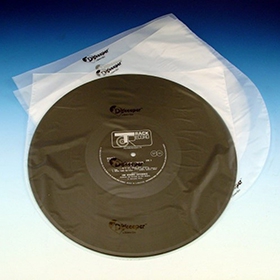
Diskeeper 1.5 Round Bottom LP Record Sleeves -
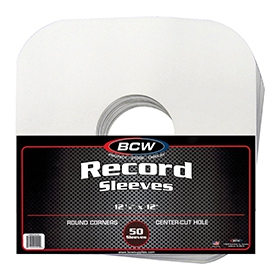
BCW Brand 12" Record White Paper Inner Sleeves
Record outer sleeves
Every record collector knows how frustrating it is to find a long wanted record in a thrift store or garage sale with the vinyl itself in good condition but the artwork cover ruined. So we recommend getting a stash of these and start using them early in your record collecting venture. Outer sleeves keep your record covers in a good condition (ideally identical to the day of purchase) and prevent ring wear, paper tears, corner dents by adding a protective layer to your valuable records. Outer sleeves are generally available in two formats, open ended and re-sealable, and have various thicknesses ranging from 2.5mm to 5mm. We suggest you get the softer ones as thick plastic sleeves can stick to the record artwork and pull pieces of it off. They usually come in bulk, so one package of these will last you a while.
-
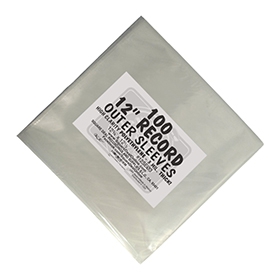
12" 3mm Record Outer Sleeves -
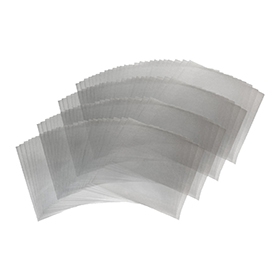
12" 4mm Record Outer Sleeves -
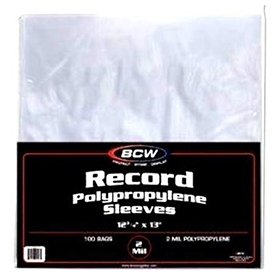
12" 2mm Record Outer Sleeves -
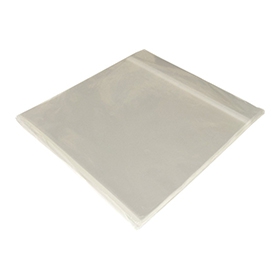
12" 2mm Super Polyclear Resealable Outer Sleeves
Record display frame
These display frames allow music lovers and art enthusiasts to easily display their favorite album artwork, change the contents and play the records without having to remove the frame from the wall. They also provide protection for your most prized albums.
-
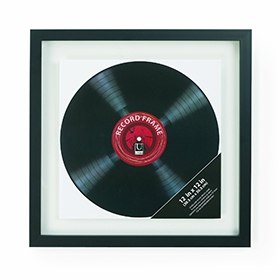
Umbra Record 12-Inch Wall Frame -
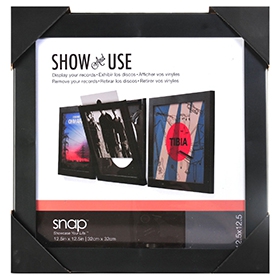
Snap Show and Use Vinyl Record Frame -
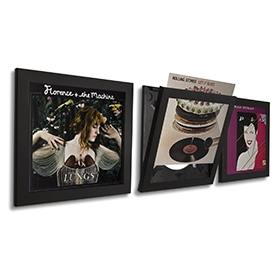
Art Vinyl Play and Display Record Frame -
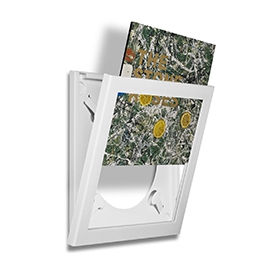
Art Vinyl Play and Display Record Frame
Record crates and storage boxes
If you don't have a dedicated record shelving system or just need some extra space to stash some records, you can always get a small LP crate to keep your albums safe, secure and organized. These functional crates will look great anywhere in the room, so you don't have to leave your vinyl on the floor or leaning against the wall.
-
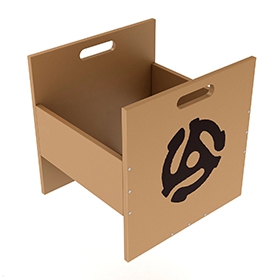
Atlantic Record Crate Shelf -
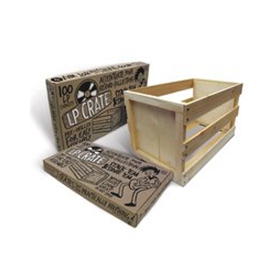
AEC LP Record Crate -
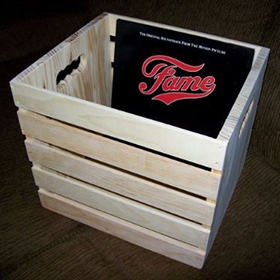
LP Storage Crate -

Diskeeper Ultimate LP Storage Crate
Record divider cards
These plastic dividers can be a very helpful accessory if you have a large record collection. Just slide them between your records on the shelf or record crate. You can categorize your collection by writing the alphabet, music genres or any other cataloging notes on the tabs.
-
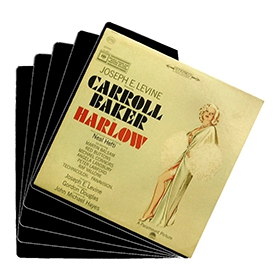
12" Record Divider Cards - Black -
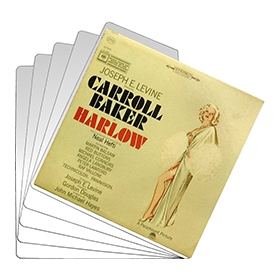
12" Record Divider Cards - White -
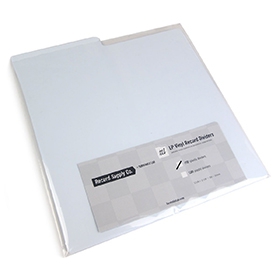
LP Dividers -
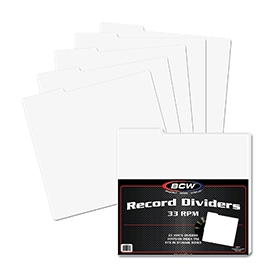
BCW Supplies 33 RPM Record Divider
Record mailer boxes
Record mailer boxes come handy when you plan on selling or exchanging records by mail as they are used to minimize risk of damage and ensure corner and edge protection of your record jackets. You can also buy these inserts, for more support, that can be slipped between and around the vinyl you're going to mail.
-
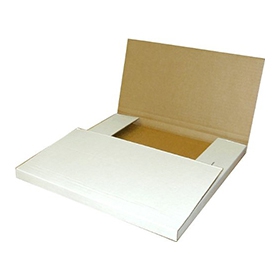
12" Variable Depth Record Mailers with One Side White -
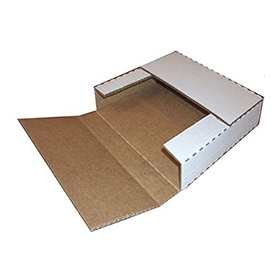
25 LP Record Mailing Boxes -
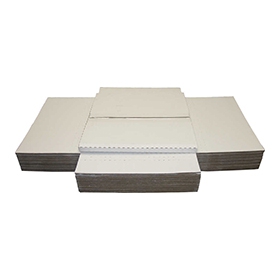
12" Record White - 1-3 Capacity - Shipping Mailers -
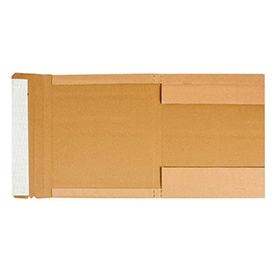
Pratt Vinyl Record Mailer
Milty Zerostat Anti Static Gun
The Zerostat is an antistatic generator which has many applications, but is used by audiophiles to remove the static charge on the surface of a record. The device generates a positive electrical charge of ions with one slow pull of the trigger, and a negative charge on release by this cancelling the charges on the vinyl instantly. To use the Zerostat, simply point it approximately two inches from the surface of the record, slowly pull the trigger and then move the Zerostat away before releasing the trigger. Repeat on four places of the LP surface and you're done. Watch a video demontration here
27 vinyl record storage and shelving solutions
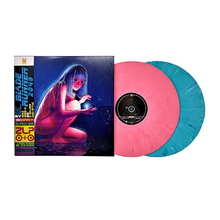 Hans Zimmer
Hans Zimmer
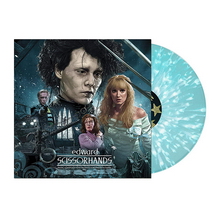 Danny Elfman
Danny Elfman
 Black Pumas
Black Pumas
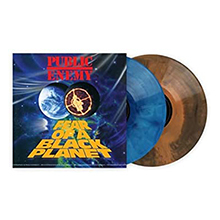 Public Enemy
Public Enemy
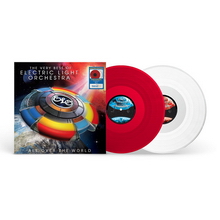 E.L.O.
E.L.O.
 Violent Femmes
Violent Femmes
 Drive-By Truckers
Drive-By Truckers
 Notorious B.I.G.
Notorious B.I.G.
 De La Soul
De La Soul
 Blink-182
Blink-182